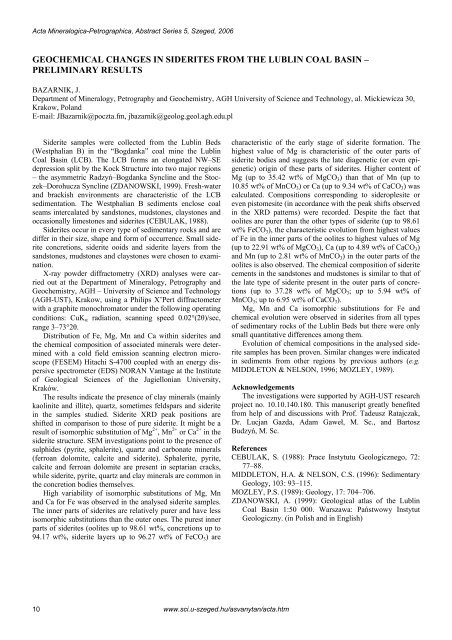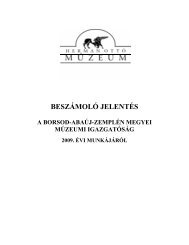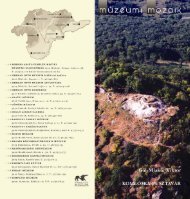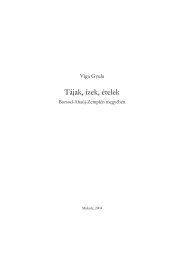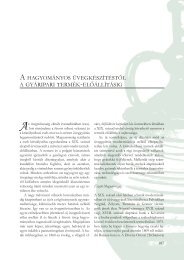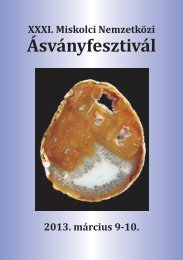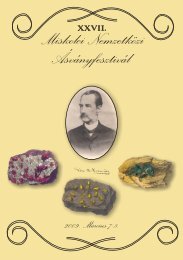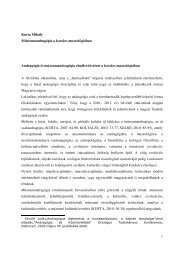Acta Mineralogica-Petrographica, Abstract Series 5, Szeged, 2006GEOCHEMICAL CHANGES <strong>IN</strong> SIDERITES FROM <strong>THE</strong> LUBL<strong>IN</strong> COAL BAS<strong>IN</strong> –PRELIM<strong>IN</strong>ARY RESULTSBAZARNIK, J.Department of Mineralogy, Petrography and Geochemistry, AGH University of Science and Technology, al. Mickiewicza 30,Krakow, PolandE-mail: JBazarnik@poczta.fm, jbazarnik@geolog.geol.agh.edu.plSiderite samples were collected from the Lublin Beds(Westphalian B) in the “Bogdanka” coal mine the LublinCoal Basin (LCB). The LCB forms an elongated NW–SEdepression split by the Kock Structure into two major regions– the asymmetric Radzyń–Bogdanka Syncline and the Stoczek–DorohuczaSyncline (ZDANOWSKI, 1999). Fresh-waterand brackish environments are characteristic of the LCBsedimentation. The Westphalian B sediments enclose coalseams intercalated by sandstones, mudstones, claystones andoccasionally limestones and siderites (CEBULAK, 1988).Siderites occur in every type of sedimentary rocks and arediffer in their size, shape and form of occurrence. Small sideriteconcretions, siderite ooids and siderite layers from thesandstones, mudstones and claystones were chosen to examination.X-ray powder diffractometry (XRD) analyses were carriedout at the Department of Mineralogy, Petrography andGeochemistry, AGH – University of Science and Technology(AGH-UST), Krakow, using a Philips X’Pert diffractometerwith a graphite monochromator under the following operatingconditions: CuK α radiation, scanning speed 0.02°(2θ)/sec,range 3–73°2θ.Distribution of Fe, Mg, Mn and Ca within siderites andthe chemical composition of associated minerals were determinedwith a cold field emission scanning electron microscope(FESEM) Hitachi S-4700 coupled with an energy dispersivespectrometer (EDS) NORAN Vantage at the Instituteof Geological Sciences of the Jagiellonian University,Kraków.The results indicate the presence of clay minerals (mainlykaolinite and illite), quartz, sometimes feldspars and sideritein the samples studied. Siderite XRD peak positions areshifted in comparison to those of pure siderite. It might be aresult of isomorphic substitution of Mg 2+ , Mn 2+ or Ca 2+ in thesiderite structure. SEM investigations point to the presence ofsulphides (pyrite, sphalerite), quartz and carbonate minerals(ferroan dolomite, calcite and siderite). Sphalerite, pyrite,calcite and ferroan dolomite are present in septarian cracks,while siderite, pyrite, quartz and clay minerals are common inthe concretion bodies themselves.High variability of isomorphic substitutions of Mg, Mnand Ca for Fe was observed in the analysed siderite samples.The inner parts of siderites are relatively purer and have lessisomorphic substitutions than the outer ones. The purest innerparts of siderites (oolites up to 98.61 wt%, concretions up to94.17 wt%, siderite layers up to 96.27 wt% of FeCO 3 ) arecharacteristic of the early stage of siderite formation. Thehighest value of Mg is characteristic of the outer parts ofsiderite bodies and suggests the late diagenetic (or even epigenetic)origin of these parts of siderites. Higher content ofMg (up to 35.42 wt% of MgCO 3 ) than that of Mn (up to10.85 wt% of MnCO 3 ) or Ca (up to 9.34 wt% of CaCO 3 ) wascalculated. Compositions corresponding to sideroplesite oreven pistomesite (in accordance with the peak shifts observedin the XRD patterns) were recorded. Despite the fact thatoolites are purer than the other types of siderite (up to 98.61wt% FeCO 3 ), the characteristic evolution from highest valuesof Fe in the inner parts of the oolites to highest values of Mg(up to 22.91 wt% of MgCO 3 ), Ca (up to 4.89 wt% of CaCO 3 )and Mn (up to 2.81 wt% of MnCO 3 ) in the outer parts of theoolites is also observed. The chemical composition of sideritecements in the sandstones and mudstones is similar to that ofthe late type of siderite present in the outer parts of concretions(up to 37.28 wt% of MgCO 3 ; up to 5.94 wt% ofMnCO 3 ; up to 6.95 wt% of CaCO 3 ).Mg, Mn and Ca isomorphic substitutions for Fe andchemical evolution were observed in siderites from all typesof sedimentary rocks of the Lublin Beds but there were onlysmall quantitative differences among them.Evolution of chemical compositions in the analysed sideritesamples has been proven. Similar changes were indicatedin sediments from other regions by previous authors (e.g.MIDDLETON & NELSON, 1996; MOZLEY, 1989).AcknowledgementsThe investigations were supported by AGH-UST researchproject no. 10.10.140.180. This manuscript greatly benefitedfrom help of and discussions with Prof. Tadeusz Ratajczak,Dr. Lucjan Gazda, Adam Gaweł, M. Sc., and BartoszBudzyń, M. Sc.ReferencesCEBULAK, S. (1988): Prace Instytutu Geologicznego, 72:77–88.MIDDLETON, H.A. & NELSON, C.S. (1996): SedimentaryGeology, 103: 93–115.MOZLEY, P.S. (1989): Geology, 17: 704–706.ZDANOWSKI, A. (1999): Geological atlas of the LublinCoal Basin 1:50 000. Warszawa: Państwowy InstytutGeologiczny. (in Polish and in English)10www.sci.u-szeged.hu/asvanytan/acta.htm
Acta Mineralogica-Petrographica, Abstract Series 5, Szeged, 2006APPLICATION OF K-Ar AGE DETERM<strong>IN</strong>ATION OF HYDRO<strong>THE</strong>RMAL CLAY <strong>M<strong>IN</strong>ERAL</strong>SFOR RECONSTRUCTION OF FLUID MOBILIZATION PROCESSES <strong>IN</strong> <strong>THE</strong> VARISCANGRANITE <strong>IN</strong>TRUSION OF <strong>THE</strong> VELENCE MTS. (TRANSDANUBIA, HUNGARY)BENKÓ, ZS. 1 , MOLNÁR, F. 1 & PÉCSKAY, Z. 21 Department of Mineralogy, Eötvös Loránd University, Pázmány Péter sétány 1/C, H-1117 Budapest, HungaryE-mail: benkoo@elte.hu2 Institute of Nuclear Research, Hungarian Academy of Sciences (ATOMKI), Bem tér 18, H-4026 Debrecen, HungaryThe age of the biotitic monzogranite intrusion in theVelence Mts. is 280-300 Ma based on K-Ar age determinationson fresh biotite (BUDA, 1985). Granite hosts vein-typequartz-polymetallic and quartz-fluorite mineralization withargillic wall rock alteration. By the time of the Palaeogeneage, several andesite veins intruded the granite and along theeastern border of the granite body a large intrusive-volcanicstructure has formed in relation to the Alpine collision. ThePalaeogene hydrothermal circulation resulted in intense alterationin the diorite intrusion and in the stratovolcanic sequenceand also caused intense argillitization and brecciationaround the andesite veins in the granite. For reconstruction ofage relationships of magmatic and hydrothermal processes,systematic mineralogical studies and K-Ar age determinationwas carried out on the K-rich mineral phases of the argillicalteration zones in the granite and on rock forming K-feldspars. Oriented and ethylene-glycolated clay mineralfractions were analysed by X-ray power diffraction (XPD)method. Morphological analysis of the clay minerals wascarried out by scanning electron microscope (SEM). Fourdifferent argillic alteration types of granite were detected: 1)Pure illite occurs along andesite veins intruding granite, alongquartz-barite veins and in hydrothermal breccias. Illite is wellcrystallized (10 µm) based on the short sedimentation timeduring smoothing and the sharpness of the (001) peaks andSEM photographs. 2) Pure kaolinite was found in the matrixof some hydrothermal breccias. 3) Mixture of illite and kaolinitewas found in hydrothermal alteration zones away fromthe andesite veins intruding granite and in the breccias. Bothmineral phases are well crystallized based on the sedimentationtime and XPD measurements. 4) Mixture of illitekaolinite-smectiteoccurs in the altered granite along polymetallicveins. Based on the sedimentation time and the XPDmeasurements, illite is less crystallized and kaolinite is thedominant mineral.The kaolinite-illite-smectite clay mineral mixtures andfresh K-feldspar along polymetallic veins of granite provided209-232 Ma K-Ar ages, obviously not matching with the280-300 Ma age of the granite. If this association did notundergo any overprint by younger hydrothermal events, thenthe age of the polymetallic mineralization is Triassic. Thusthis type of mineralization could be related to a regional heateffect causing fluid mobilization. Regional fluid mobilizationand mineralizing processes forming Pb-Zn deposits arewidely known in relation to the early opening of the Tethysoceanin the Alp-Carpathian-Dinaride region.K-Ar ages for the illite-kaolinite association scatter between55 and 125 Ma. The 55-125 Ma ages may reflect thefluid mobilization effect of the Alpine subduction-collisionevents. Theoretically, it also cannot be excluded that hydrothermalfluids of Palaeogene volcanic events penetrated thewhole granite body and overprinted the radiometric clock ofthe Variscan minerals due to their heat effect, however, systematicfluid inclusion studies (MOLNÁR, 2004) do notconfirm the regional character of the Palaeogene hydrothermalcirculation within the granite body.The K-Ar age of pure illite samples is between 40-29 Ma.The younger ages corresponds to the 29-31 Ma age of alunitefrom the hydrothermally altered stratovolcanic series and K-Ar ages for K-feldspar and illite from the diorite intrusionalong the eastern boundary of granite (BAJNÓCZI, 2004).The 33-40 Ma K-Ar age range of some illite samples correspondto the K-Ar age of andesite veins intruding granite.The age of the quartz-barite vein mineralization in the graniteis also Palaeogene based on the 30 Ma age of illite alongthose veins.Results indicate that systematic analysis of K-rich clayminerals from argillic alteration zones and rock formingminerals in old granite intrusions provides new aspects todiscrimination fluid circulation events. Determination of theradiometric age of those events contributes to the better understandingof the tectonic and geodynamic evolution of thearea.ReferencesBAJNÓCZI B. (2005): Tertiary hydrothermal systems of theVelence Mountains. Unpublished PhD Thesis, Budapest:Eötvös L. University, 79–86. (in Hungarian)BUDA, GY. (1985): Origin of collision-type Variscan granitoidsin Hungary, West Carpathian and Central BohemianPluton. Unpublished CSc Thesis, Budapest: HungarianAcademy of Sciences, 95. (in Hungarian)MOLNÁR F. (2004): Acta Mineralogica–Petrographica, 45:39–48.www.sci.u-szeged.hu/asvanytan/acta.htm 11
- Page 1: MSCC33 rd MINERAL SCIENCES IN THE C
- Page 5 and 6: Acta Mineralogica-Petrographica, Ab
- Page 7 and 8: Acta Mineralogica-Petrographica, Ab
- Page 9: Acta Mineralogica-Petrographica, Ab
- Page 13 and 14: Acta Mineralogica-Petrographica, Ab
- Page 15 and 16: Acta Mineralogica-Petrographica, Ab
- Page 17 and 18: Acta Mineralogica-Petrographica, Ab
- Page 19 and 20: Acta Mineralogica-Petrographica, Ab
- Page 21 and 22: Acta Mineralogica-Petrographica, Ab
- Page 23 and 24: Acta Mineralogica-Petrographica, Ab
- Page 25 and 26: Acta Mineralogica-Petrographica, Ab
- Page 27 and 28: Acta Mineralogica-Petrographica, Ab
- Page 29 and 30: Acta Mineralogica-Petrographica, Ab
- Page 31 and 32: Acta Mineralogica-Petrographica, Ab
- Page 33 and 34: Acta Mineralogica-Petrographica, Ab
- Page 35 and 36: Acta Mineralogica-Petrographica, Ab
- Page 37 and 38: Acta Mineralogica-Petrographica, Ab
- Page 39 and 40: Acta Mineralogica-Petrographica, Ab
- Page 41 and 42: Acta Mineralogica-Petrographica, Ab
- Page 43 and 44: Acta Mineralogica-Petrographica, Ab
- Page 45 and 46: Acta Mineralogica-Petrographica, Ab
- Page 47 and 48: Acta Mineralogica-Petrographica, Ab
- Page 49 and 50: Acta Mineralogica-Petrographica, Ab
- Page 51 and 52: Acta Mineralogica-Petrographica, Ab
- Page 53 and 54: Acta Mineralogica-Petrographica, Ab
- Page 55 and 56: Acta Mineralogica-Petrographica, Ab
- Page 57 and 58: Acta Mineralogica-Petrographica, Ab
- Page 59 and 60: Acta Mineralogica-Petrographica, Ab
- Page 61 and 62:
Acta Mineralogica-Petrographica, Ab
- Page 63 and 64:
Acta Mineralogica-Petrographica, Ab
- Page 65 and 66:
Acta Mineralogica-Petrographica, Ab
- Page 67 and 68:
Acta Mineralogica-Petrographica, Ab
- Page 69 and 70:
Acta Mineralogica-Petrographica, Ab
- Page 71 and 72:
Acta Mineralogica-Petrographica, Ab
- Page 73 and 74:
Acta Mineralogica-Petrographica, Ab
- Page 75 and 76:
Acta Mineralogica-Petrographica, Ab
- Page 77 and 78:
Acta Mineralogica-Petrographica, Ab
- Page 79 and 80:
Acta Mineralogica-Petrographica, Ab
- Page 81 and 82:
Acta Mineralogica-Petrographica, Ab
- Page 83 and 84:
Acta Mineralogica-Petrographica, Ab
- Page 85 and 86:
Acta Mineralogica-Petrographica, Ab
- Page 87 and 88:
Acta Mineralogica-Petrographica, Ab
- Page 89 and 90:
Acta Mineralogica-Petrographica, Ab
- Page 91 and 92:
Acta Mineralogica-Petrographica, Ab
- Page 93 and 94:
Acta Mineralogica-Petrographica, Ab
- Page 95 and 96:
Acta Mineralogica-Petrographica, Ab
- Page 97 and 98:
Acta Mineralogica-Petrographica, Ab
- Page 99 and 100:
Acta Mineralogica-Petrographica, Ab
- Page 101 and 102:
Acta Mineralogica-Petrographica, Ab
- Page 103 and 104:
Acta Mineralogica-Petrographica, Ab
- Page 105 and 106:
Acta Mineralogica-Petrographica, Ab
- Page 107 and 108:
Acta Mineralogica-Petrographica, Ab
- Page 109 and 110:
Acta Mineralogica-Petrographica, Ab
- Page 111 and 112:
Acta Mineralogica-Petrographica, Ab
- Page 113 and 114:
Acta Mineralogica-Petrographica, Ab
- Page 115 and 116:
Acta Mineralogica-Petrographica, Ab
- Page 117 and 118:
Acta Mineralogica-Petrographica, Ab
- Page 119 and 120:
Acta Mineralogica-Petrographica, Ab
- Page 121 and 122:
Acta Mineralogica-Petrographica, Ab
- Page 123 and 124:
Acta Mineralogica-Petrographica, Ab
- Page 125 and 126:
Acta Mineralogica-Petrographica, Ab
- Page 127 and 128:
Acta Mineralogica-Petrographica, Ab
- Page 129 and 130:
Acta Mineralogica-Petrographica, Ab
- Page 131 and 132:
Acta Mineralogica-Petrographica, Ab
- Page 133 and 134:
Acta Mineralogica-Petrographica, Ab


